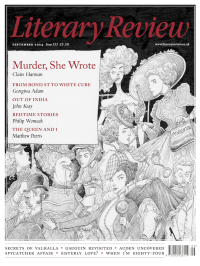William Whyte
Rich in Meaning
Money Talks: Art, Society & Power
Ashmolean Museum, Oxford, until 5 January 2025
Money isn’t what it was. Only about 14 per cent of transactions in the UK now involve cash. In Norway, the figure is as low as 3 per cent. It is widely reckoned that Sweden, the first European country to issue banknotes, will become the first in the world to cease printing them. Next door, the state bank of Finland predicts that the country will be totally cashless by 2029. Blockchains, non-fungible tokens, digital wallets and simple chip-and-pin debit cards – all of these technologies seem to threaten something that was, until only recently, an apparently fundamental part of modern life. Paper money and metallic coinage seem more vulnerable than we might ever have expected.
It’s a good time to reflect on what money once meant and what it might mean in the future. Visitors to the Ashmolean’s new exhibition are left in no doubt that it matters. At the entrance, they are greeted by two huge assertions of that fact. On the right is a two-metre-high gold dollar sign painted by Andy Warhol. ‘Making money is art and working is art and good business is the best art’, reads one of his obiter dicta beside it. On the left is an even more substantial statement. Unicode, by Indian-born artist Tallur L N, is a big ball of concrete encircled by a gilded flaming halo. It looks like an altarpiece for devotees of a meteor-worshipping sect. In fact, it’s a play on the Nataraja, a representation of the god Shiva dancing, one of the most famous motifs in Indian art. As one leans in to look, it becomes clear that the rough surface of the concrete is pitted with coins.
Looking closely is a useful habit for the visitor to get accustomed to. After these two big opening pieces, most of the exhibition is made up of much smaller things, both historical artefacts and contemporary artworks. The one major exception – the seemingly obligatory piece by Grayson Perry, standard issue

Sign Up to our newsletter
Receive free articles, highlights from the archive, news, details of prizes, and much more.@Lit_Review
Follow Literary Review on Twitter
Twitter Feed
Under its longest-serving editor, Graydon Carter, Vanity Fair was that rare thing – a New York society magazine that published serious journalism.
@PeterPeteryork looks at what Carter got right.
Peter York - Deluxe Editions
Peter York: Deluxe Editions - When the Going Was Good: An Editor’s Adventures During the Last Golden Age of Magazines by Graydon Carter
literaryreview.co.uk
Henry James returned to America in 1904 with three objectives: to see his brother William, to deliver a series of lectures on Balzac, and to gather material for a pair of books about modern America.
Peter Rose follows James out west.
Peter Rose - The Restless Analyst
Peter Rose: The Restless Analyst - Henry James Comes Home: Rediscovering America in the Gilded Age by Peter Brooks...
literaryreview.co.uk
Vladimir Putin served his apprenticeship in the KGB toward the end of the Cold War, a period during which Western societies were infiltrated by so-called 'illegals'.
Piers Brendon examines how the culture of Soviet spycraft shaped his thinking.
Piers Brendon - Tinker, Tailor, Sleeper, Troll
Piers Brendon: Tinker, Tailor, Sleeper, Troll - The Illegals: Russia’s Most Audacious Spies and the Plot to Infiltrate the West by Shaun Walker
literaryreview.co.uk